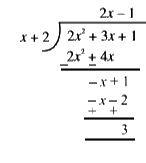Determine whether each of the following statement patterns is a tautology or a contradiction or contingency :
(1) [(p→q)∧~q]→(~p)
(2) (p∧~q)⇔(p→q)
(3) (p∧q)∨(p∧r)
Video Solution
Text Solution

All the entries in the last column of the above truth table are T.
∴[(p→q)∧~q]→(~p) is a tautology.

All the entries in the last column of the above truth table are F.
∴(p∧~q)⇔(p→q) is a contradiction.

The entries in the last column of the abvoe truth table are neither all T nor all F.
∴(p∧q)∨(p∧r) is a contingency.
|
Topper's Solved these Questions
- MATHEMATICAL LOGICBOOK - NAVNEET PUBLICATION - MAHARASHTRA BOARDCHAPTER - MATHEMATICAL LOGICEXERCISE - EXAMPLES FOR PRACTICE 2 OR 3 MARKS EACH
24 Videos
- MATHEMATICAL LOGICBOOK - NAVNEET PUBLICATION - MAHARASHTRA BOARDCHAPTER - MATHEMATICAL LOGICEXERCISE - EXAMPLES FOR PRACTICE 3 MARKS EACH
4 Videos
- LINEAR PROGRAMMING BOOK - NAVNEET PUBLICATION - MAHARASHTRA BOARDCHAPTER - LINEAR PROGRAMMING EXERCISE - EXAMPLES FOR PRACTICE
8 Videos
- MATRICESBOOK - NAVNEET PUBLICATION - MAHARASHTRA BOARDCHAPTER - MATRICESEXERCISE - MULTIPLE CHOICE QUESTIONS
12 Videos
Similar Questions
Knowledge Check
The statement p∨q is
Aa tautologyBa contradictionCcontingencyDnone of these~[(p∧q)→(~p∨q)] is a
AtautologyBcontradictionCNeither (a) nor (b)DEither (a) or (b)The dual of (p∧t)∨(c∧~q) where t is a tautology and c is a contradiction, is
A(p∨c)∧(t∨~q)B(~p∧c)∧(t∨q)C(~p∨c)∧(t∨q)D(~p∨t)∧(c∨~q)
Answer the following questions
Examine whether the statement pattern is a tautology, contradiction or contingency
(p∧~q)→(~p∧~q)
View SolutionUsing truth tables. Examine whether the stateements pattern (p∧q)v(p∧r) is tautology. Contradiction or continegency.
View SolutionWhich of the following statement is acontradiction (p∧q)∧(~(p∨q))
View SolutionVerify that the statement P∨~(p∧q) is a tautology.
View Solutionp∧(q∨r)≡(p∧q)∨(p∧r) is :
View Solution
